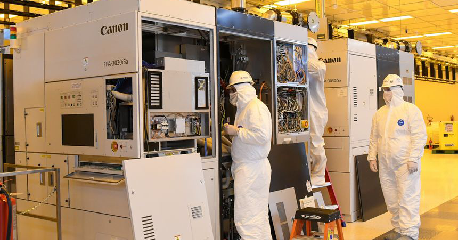
Industry group Semi late last month lowered its forecast for global equipment spending in 2023 to $97 billion.
PHOTO CREDIT: HEATHER AINSWORTH FOR THE WALL STREET JOURNAL
Lam's forecast for a sharp slowdown in industry capital spending helped reset investor expectations and pushed chip stocks higher.
For makers of semiconductor manufacturing equipment, winter is coming. But the prospect has warmed investors' hearts.
Lam Research Co. (LRCX) reported strong first-quarter results Wednesday night. Both revenue and operating profit topped Wall Street forecasts, and revenue growth actually accelerated from the previous two quarters, which were constrained by the inability of Lam and many of its peers to ship finished equipment to customers due to parts shortages. Catching up on shipments will continue to benefit Lam in the near term; the company expects revenue of $5.1 billion in the December quarter, 6% above analysts' forecasts.
However, Lam also provided the clearest signal yet that the boom cycle for the chip industry since the outbreak was coming to an end. The company expects industry-wide capital spending on production equipment to fall by 20% next year — a figure that already reflects the expected impact of new rules restricting exports of chip equipment to China.
That would be the steepest drop in such capital spending since 2009, according to historical data from TechInsights. That means spending is just over $70 billion, well below the more than $100 billion expected by many earlier this year. Industry group Semi late last month lowered its forecast for global equipment spending in 2023 to $97 billion, from a target of $109 billion published in June.
Such pessimism usually sends related stocks tumbling, but shares of Fanlin Group jumped 8% in early trade on Thursday. Similar chip equipment stocks also rose strongly; the PHLX Semiconductor Index rose more than 2%, compared with a 0.5% gain for the Nasdaq Composite. Analysts warmly welcomed the forecast as a necessary reset of expectations for investors who have been hesitant to enter the highly cyclical sector.
Lam's results and forecasts also confirm that the pain of the chip industry slowdown won't be shared equally. ASML (ASML Holding NV, ASML) also reported strong results earlier on Wednesday, but doesn't expect a major hit to business next year as long queues line up for foundry chipmakers that need its high-end lithography equipment; These devices are essential for state-of-the-art production processes. By contrast, about 60 percent of Lam's business comes from the memory market, where sales have fallen and major producers such as Micron Technology Inc. (MU) are sharply scaling back spending plans.
Analysts expect Lam's revenue to fall by more than 5% in calendar year 2023, while ASML's revenue will rise 19% in the same period, according to FactSet. But Stifel's Brian Chin said ASML's unique position made it "not a good measure" for the rest of the industry. In this sense, more sunlight can be seen from Lam's darker perspective.


